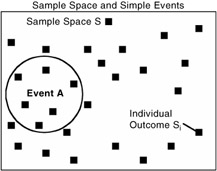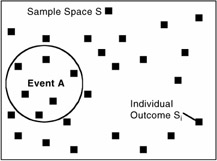Six Sigma and Beyond: Statistics and Probability, Volume III
-
Equivalent to universal space U
-
Related to a random experiment
-
Uncertainty of results or outcomes
-
-
Consists of all possible outcomes or samples
-
Each output is a simple or elementary event, S i
-
Discrete, e.g., selecting a card or coin tosses
-
Continuous, e.g., diameter or weight of rods
-
Finite or infinite

-
-
Events of sample space: A
-
Simple or elementary event is one (individual) outcome of sample space, S i .

-
An event A is a subset or grouping of simple events; e.g., event A of n simple events: A = {S 1 , ..., S n }
-
Elements of event A are samples with defined characteristics; e.g., the odd numbers tossed on dice.
-
If the outcome of an experiment S i is an element of A, then "the event A has occurred."
EXAMPLES OF SETS
Given: Random experiment in a twice-tossed coin.
-
Find the sample space S of the four possible outcomes:
Simple events: S 1 = TT, S 2 = HT, S 3 = HH, S 4 = TH
Sample space: S = (S 1 , S 2 , S 3 , S 4 )
-
Find the subset or event A defined as when: At least one head occurs.
Event A = (HT, HH, TH) = (S 2 , S 3 , S 4 )
-
Find the subset or event B defined as when: At least one tail occurs.
Event B = (TT, HT, TH) = (S 1 , S 2 , S 4 )
-
Find the subset or event C defined as when: At least one head (event A) AND one tail (event B) occur.
Event C = (HT, TH) = (S 2 , S 4 )
"AND" in set theory is an "intersection," meaning "both A and B."
C
‰
A ‹‚ B
‰
(S 2 , S 4 )
-
Find the subset or event D defined as when: The first toss is a head.
Event D = (HT, HH) = (S 2 , S 3 )
-
Find the subset or event E defined as when: At least one head (event A) OR at least one tail (event B) occurs.
Event E = (TT, HT, HH, TH) = (S 1 , S 2 , S 3 , S 4 )
"OR" in set theory is "union," meaning "either A or B or both."
E ‰ A ‹ƒ B = (S 1 , S 2 , S 3 , S 4 ) = S
-
Find the event F that CANNOT occur assuming the event A does occur. Event A is defined as when at least one head occurs.
Event A = (HT, HH, TH) = (S 2 , S 3 , S 4 )
Event F is the event "not A."
Event F = (TT) = (S 1 )
Event A and event F are " mutually exclusive" or " disjoint " in set theory.
A ‹‚ F = =A ‹‚ A'
Hence the event
F = A' = (S 1 ) = (TT)